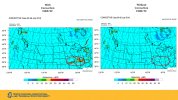Dear WRF Community,
I am working on a July 05-06, 2018, moist convective case, which produces heavy precipitation near the Chicago area. I am using WRFV4.4 to simulate this case. I was able to simulate it successfully, and the results were well comparable with observations (Test1). However, when I ran the same simulation after 2 months (Test2), I found completely different and strange results, especially while comparing Reflectivity. I was supposed to see convection near the Chicago area at 1900 UTC on 5th July, which is completely missing in the second simulation. Please see the attached image. Note that Test2 is completely identical to Test1.
I have done several tests to get rid of it, including re-compiling WRFV4.4, using different WRF versions, different initialization times, different datasets, different physics schemes, etc. Unfortunately, I got the results without convection near the Chicago area for all those tests.
I am now at the point with a loss of ideas. Could anyone please help me to resolve this issue?
My working directory in Cheyenne: /glade/scratch/skarim/CROCUS_Dr_Kaplan/WRFV4.4/run/Test1 and Test2
I have also attached the namelist.input that I use for Test1 and 2.
I would be really grateful if someone could help me.
Thanks in advance.
With Kind Regards
Shak
I am working on a July 05-06, 2018, moist convective case, which produces heavy precipitation near the Chicago area. I am using WRFV4.4 to simulate this case. I was able to simulate it successfully, and the results were well comparable with observations (Test1). However, when I ran the same simulation after 2 months (Test2), I found completely different and strange results, especially while comparing Reflectivity. I was supposed to see convection near the Chicago area at 1900 UTC on 5th July, which is completely missing in the second simulation. Please see the attached image. Note that Test2 is completely identical to Test1.
I have done several tests to get rid of it, including re-compiling WRFV4.4, using different WRF versions, different initialization times, different datasets, different physics schemes, etc. Unfortunately, I got the results without convection near the Chicago area for all those tests.
I am now at the point with a loss of ideas. Could anyone please help me to resolve this issue?
My working directory in Cheyenne: /glade/scratch/skarim/CROCUS_Dr_Kaplan/WRFV4.4/run/Test1 and Test2
I have also attached the namelist.input that I use for Test1 and 2.
I would be really grateful if someone could help me.
Thanks in advance.
With Kind Regards
Shak

